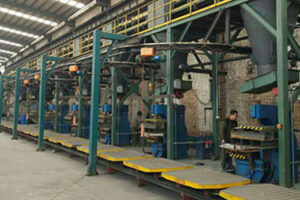The Magic of Green Sand Casting: How It Works
 Green sand casting is a popular method of metal casting that has been used for centuries. It is a cost-effective and efficient way of producing complex metal parts, and it is widely used in the automotive, aerospace, and construction industries. In this article, we will explore the magic of green sand casting and how it works.
Green sand casting is a popular method of metal casting that has been used for centuries. It is a cost-effective and efficient way of producing complex metal parts, and it is widely used in the automotive, aerospace, and construction industries. In this article, we will explore the magic of green sand casting and how it works.
What is Green Sand Casting?
Green sand casting is a type of sand casting that uses a mixture of sand, clay, and water as the molding material. The sand is called “green” because it is moist and has not been baked or dried. The mixture is packed around a pattern, which is a replica of the part to be cast. The pattern is removed, leaving a cavity in the sand that is the exact shape of the part.
How Does Green Sand Casting Work?
Green sand casting works by pouring molten metal into the cavity created by the pattern. The metal fills the cavity and takes on the shape of the part. Once the metal has cooled and solidified, the sand is broken away, revealing the finished part.
The process of green sand casting can be broken down into several steps:
Step 1: Pattern Making
The first step in green sand casting is pattern making. A pattern is a replica of the part to be cast, and it is made from wood, plastic, or metal. The pattern is used to create the cavity in the sand that will be filled with molten metal.
Step 2: Molding
Once the pattern is made, it is placed in a flask, which is a box-like container that holds the sand. The sand is mixed with water and clay to create a molding material that is packed around the pattern. The sand is compacted to ensure that it is tightly packed around the pattern.
Step 3: Pouring
Once the sand is packed around the pattern, the flask is inverted, and the pattern is removed. This leaves a cavity in the sand that is the exact shape of the part. The molten metal is then poured into the cavity through a sprue, which is a channel that allows the metal to flow into the cavity.
Step 4: Cooling
After the metal has been poured into the cavity, it begins to cool and solidify. The cooling time depends on the size and complexity of the part. Once the metal has cooled, the sand is broken away, revealing the finished part.
Step 5: Finishing
The finished part may require some finishing work, such as grinding, sanding, or polishing. This is done to remove any rough edges or imperfections and to give the part a smooth, polished finish.
Advantages of Green Sand Casting
Green sand casting has several advantages over other methods of metal casting. It is a cost-effective and efficient way of producing complex metal parts. It is also a versatile method that can be used to cast a wide range of metals, including iron, steel, aluminum, and copper.
Another advantage of green sand casting is that it produces parts with a high degree of accuracy and detail. The sand molds can be made to very precise specifications, and the finished parts are often very close to the original pattern.
Conclusion
Green sand casting is a fascinating and complex process that has been used for centuries to produce metal parts. It is a cost-effective and efficient way of producing complex parts, and it is widely used in the automotive, aerospace, and construction industries. By understanding how green sand casting works, we can appreciate the skill and craftsmanship that goes into producing the metal parts that we use every day.






